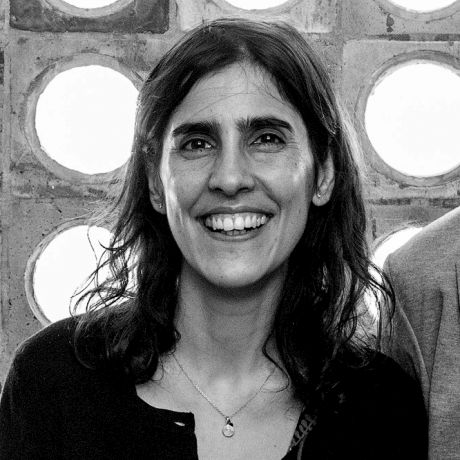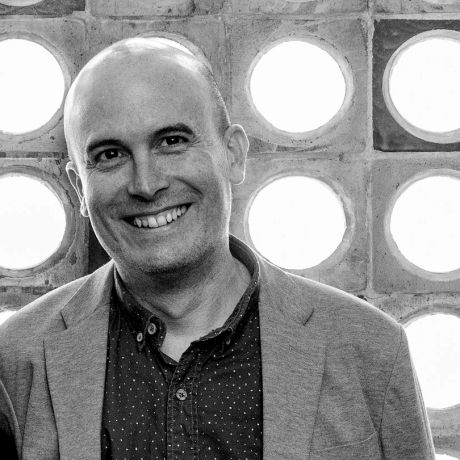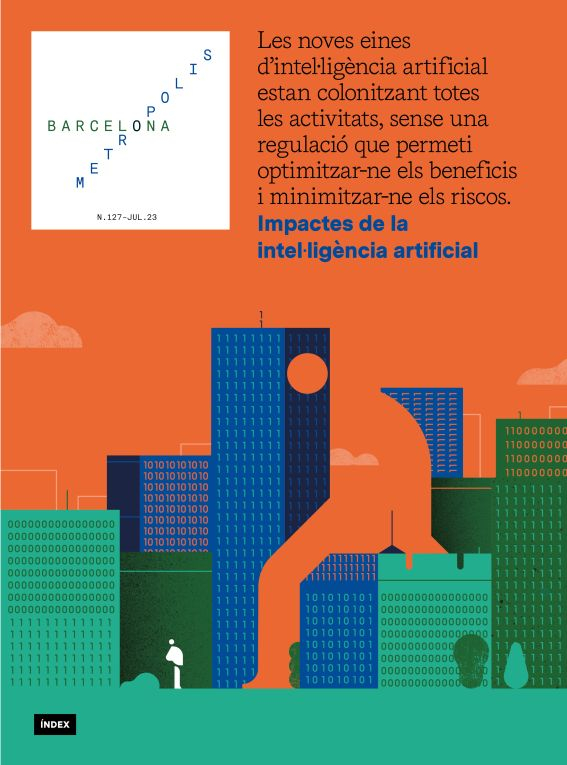
The polarisation and segregation fuelled by algorithms may end up shaping the city. AI feeds off itself and, as if it were an infinite mirror, it insists on showing us what it knows, but it does not put forward alternative models. As citizens we must learn to use it, so to prevent it from taking over our decisions.
In today’s city, cars don’t fly and holograms don’t take over the streets. Our houses are mostly made of brick, cardboard, plaster and, at best, wood. This does not alter the fact that advanced technologies are already embedded in our urban fabric, even though we may not notice them nor do they make their presence felt in an obvious fashion. The city we see and touch is the product of a long historical process in which stone infers the pace of slow physical transformation, while the city we experience (made up of relationships and attachments) is rapidly transforming at the pace of technology. This city is mediated, today, by the massive analysis of data generated with artificial intelligence (AI) tools, which are fuelled by a parallel world called the internet, in which social pacts on public space do not exist and consensuses are determined by big corporations.
In this city, falling in love at a pedestrian crossing is no longer a random twist of fate. It is an inevitable outcome of the micro-targeting that guides our decisions. A strategy that closely aligns shops and other places targeting similar audiences, which are also visited by other citizens (who have received advertisements or recommendations from followers on social media), as a result of the analysis of the data trail that we constantly leave behind and that others capture without us noticing. This is how the urban dance of passers-by on the streets is not only predictable, but is also, in turn, influenced by the digital map that precedes our decisions. In this city, the only possible urban dérive is that of a tourist without roaming trying to find their way on Google Maps.
If Richard Sennett[1] describes the city as the place where strangers are most likely to meet strangers, we can affirm that the city as he understands it is in crisis. The random, spontaneous, improbable and haphazard is gradually disappearing, as the digital realm that facilitates and guides our decisions merges with our lives (some already call this the metaverse). This is how the very polarisation and segregation in social networks that feeds so many AI algorithms can end up shaping the city, organising the public space, reducing the complexity and mix of diversities and opposites, diminishing social mobility and, finally, reducing the capacity of the city itself as a tool for wealth redistribution.
 Illustration © Romualdo Faura
Illustration © Romualdo FauraWe are convinced that accurately describing our cities should facilitate and push us towards better decision-making. This conviction is accompanied by the rise in information storage capacity, the ease with which sensors can be attached to any process and the omnipresence of telecommunications networks capable of transferring all these data flows. However, faced with the huge volume of information acquired (and which should enlighten us), we discover that this excess is beyond our comprehension, and that we require algorithmic techniques to help us to operate within the data.
AI as an infinite mirror
AI-based techniques do not unravel the rationale behind urban phenomena, but feed on what they have been shown and are able to reproduce it with certain virtuosity, thereby creating the wonderful illusion of making decisions on highly complex systems that they are incapable of understanding. Those who feel uncomfortable diving into the apparent incoherencies of the urban, or those who seek to improve a part of its constituent processes separately, without looking at the whole, can find great comfort and satisfaction in these tools.
Under this operating framework, AI, in its capacity to reproduce and recombine information on previous situations, is clearly capable of managing processes: it optimises routes, reduces consumption and minimises adverse impacts. Nevertheless, although all this is necessary, it does not propose alternative models. For example, in an AI-managed mobility system, traffic jams are reduced and journey times and driver satisfaction are improved. However, it does not reduce traffic, but makes more cars fit on the streets. Therefore, it does not transform the current mobility system that has such clear impacts on climate change.
Faced with the implausibility of defining an alternative model, AI accentuates the present. Many of the AIs already operating on a regular basis feed on the results of their own decisions. Like an echo chamber or an infinite mirror, they insist on showing us what they know, over and over again. An everyday example is restaurant recommendation algorithms, which ensure that the highest ranked restaurants get the most visits and thus, day after day, hold on to their leading position, making it almost impossible to alter it without external intervention. And this, which may seem anecdotal, influences the street where this establishment is located, affects the prices of adjacent establishments and pushes other parts of the city into oblivion.
Restaurants recommendation algorithms influence the street where the establishments are located, affects the prices of adjacent establishments and pushes other parts of the city into oblivion.
There are also other AIs beyond shopping recommendation algorithms or chat rooms that can help the cheekiest of us to do our homework. Let’s take a look at research such as that currently being carried out by the Barcelona Supercomputing Center as part of the Impetus4Change[2] project to improve predictions of severe weather events associated with climate change. Thanks to the use of these new methodologies, heat waves or floods can be anticipated weeks and months in advance, and with greater precision than that achieved by current methodologies (both in terms of time and spatial resolution), which will help us to adapt better to climate change.
Another case is the Mercè experiment, part of the Urban Citizen Learning project,[3] in which citizens deliberately train an AI algorithm to help them understand how the parameters that describe the urban environment work together to produce liveable environments. The project seeks to quantify certain aspects of the urban environment, which until now could not be described objectively but which, thanks to AI, can be measured with a view to regulating and appraising them in the future.
Hacking IA
Whatever our capacity to engage in these major projects, as citizens we must learn to use and hack AI on an everyday basis. To use it so that the benefits it yields are not the preserve of the few, and to hack it to prevent it from taking over our decisions, to strip it of its power to have knowledge of everything and to deactivate it without having to press a button.
For example, young streamers[4] in China broadcast from the public space of well-to-do neighbourhoods that are usually given greater visibility by AI algorithms for social media positioning. Another example is that of Simon Weckert,[5] who slowly drover a cart filled with mobile phones through the streets to simulate, in the eyes of Google Maps, a traffic jam that clears the city of cars, inducing the route-planning AI to look for less congested routes. Other popular ways to “tease” the AI can be the use of clothing patterns created with the same images that were used in its training. This ends up confusing facial recognition algorithms, which guarantee invisibility to video surveillance cameras.
The common good versus corporate profit
We have created a world that is hard to understand, made up of complex human devices (such as the city itself) that can only be operated by other human devices, such as AI itself. We can envisage uses in which tools such as ChatGPT help us, for example, to interpret[6] the complex maze of legal documents[7] needed to operate in the city. But we can also rethink all these documents, simplify them, adjust them and find a way to make them understandable without interpreters, without tools other than those used in their writing.
The future is neither written nor is it an inherent outcome of technology. No matter how many decisions we might delegate to AI, we (the citizens) must be the ones to define the model of society we would like technology to shape. It is up to us to decide whether we want AI to turn the city into the playground of a few, or whether we want it to be used to survive climate change in a more egalitarian society. And for the latter, stretching the current urban model to the extreme will not suffice, but we will have to rethink the rationales that AI fails to unravel, so that we can reconstruct and agree on a new model to guide us into the future.
Therefore, we must learn to take control of AI, we must co-opt AI (don’t miss the series of videos hosted by Mona Sloane on the subject)[8]. From the public arena, we must monitor and define its limits, building, designing and experimenting with it, thereby delivering positive achievements for the common good in the face of the huge number of AI algorithms that are geared towards corporate profit today.
We will have to consider what role we can play in a scenario in which big corporations invest more in R&D than governments themselves (Amazon exceeds public and private spending on innovation in Spain). And we should consider whether it makes sense for government bodies to support the research carried out by large companies in this field purely for their own profit. Or how we can intertwine these technologies with future public policies.
Getting back to the city, the reverberations of AI may end up shaping it and giving rise to a more uniform social organisation, in which errors, the unusual, the random, the spontaneous and the bizarre disappear. That the economic and social model we oppose – a model in which poverty and opulence are part of the way it works – may end up not being called into question but, on the contrary, optimised. That urban space becomes an arena for micro-targeting. These are all risks that we will have to address and be constantly on the alert for. Let us resist the pleasure of a friendly, clear and clean city. Let us look behind it. Let the city make us uneasy, both in terms of what we see in it and in terms of the trouble we have in understanding it.
[1] “Announcing new event series. Co-Opting AI: Public Conversations About Design, Inequality, and Technology”. Institute for Public Knowledge. New York University, 2019. http://ow.ly/ZvB150OoGjm. Open in a new window
[1] Sennett, R. Construir i habitar. Ètica per a la ciutat. Editorial Arcàdia. Barcelona, 2019.
[2] https://impetus4change.eu/
[4] Amantegui, A. “Por qué las streamers chinas se juntan bajo el puente de un barrio rico para emitir sus directos”. La Vanguardia, 2023. https://ow.ly/1KxN50OQjgr
[5] Weckert, S. “Google Maps Hacks”. 2020. http://ow.ly/F4me50OoGfM
[6] Tilbe, A. “Complete ChatGPT Guide for Lawyers: Top 20 Essential Prompts”. Medium, 2023. http://ow.ly/WKkn50OoGgX
[7] Portal jurídic de l’Ajuntament de Barcelona. http://ow.ly/pWtT50OoGib
[8] “Announcing new event series. Co-Opting AI: Public Conversations About Design, Inequality, and Technology”. Institute for Public Knowledge. New York University, 2019. http://ow.ly/ZvB150OoGjm
The newsletter
Subscribe to our newsletter to keep up to date with Barcelona Metròpolis' new developments





